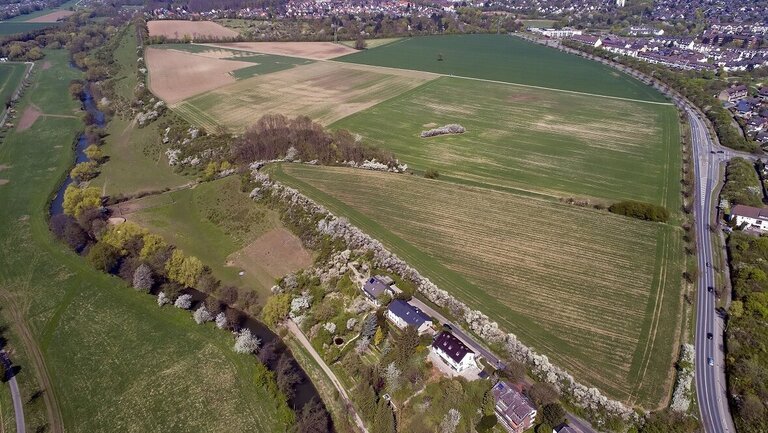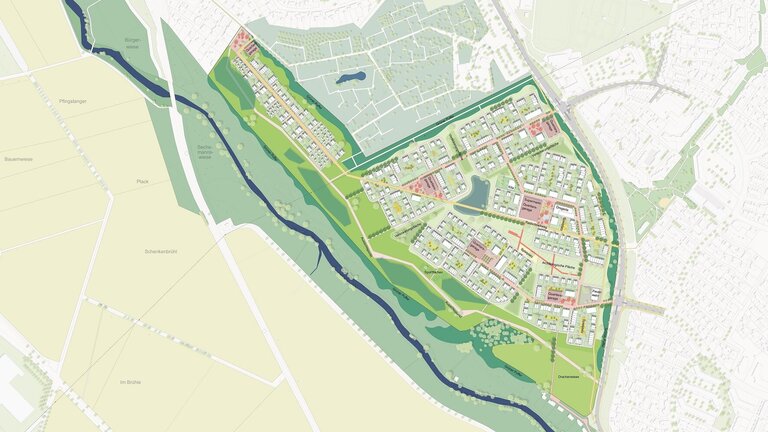Hildesheim, Germany, March 7, 2023. In the middle of the action and actively involved: The city of Hildesheim is planning a new residential area – and it uses a citizen questionnaire to bring the citizens on board even in the planning phase. More than six hundred local residents and interested persons gave feedback on the future urban development concept, and their ideas will actively influence the development process for the Wasserkamp residential area. The city has commissioned three offices with the preparation of an urban development design and a district-based mobility, energy, water and biodiversity concept with the participation of the local population. Among the developers is the Stuttgart-based consulting company Drees & Sommer SE.
Public participation offers a great opportunity for cities and local communities. Participation and transparency are increasingly being brought into focus in urban development and urban planning. Citizen questionnaires enable interested citizens to play an active role in the improvement of their local communities and to influence current projects with their opinions – for example in the planned Wasserkamp residential area on the southern outskirts of the city of Hildesheim. The benefits of early public participation are a reduction in public outcry, greater understanding and the opportunity for people to contribute their own ideas and wishes to the concept.
Public Participation as an Opportunity
The Wasserkamp project aims to create a varied and yet individual neighborhood for housing, life quality and working. To this end we need a concept which meets the needs of the local population and covers many aspects to ensure a pleasant place to live in. We do not want to simply plan everything on the drawing board, we want to actively integrate the ideas and wishes of the people of Hildesheim,’ explains Sandra Brouër, Head of Urban Planning and Urban Development at Hildesheim’s city administration. More than six hundred people took part in the municipal questionnaire for the planned development area and expressed their wishes, suggestions, misgivings and fears.
Wasserkamp is situated on the southern outskirts of the city, between Hildesheim’s Itzum district and a special conservation area for flora and fauna, and is currently mainly used for agriculture. A wide strip of the special conservation area is situated along the Wasserkamp, and the Innerste river meanders along through the planned new neighborhood. From the hill at Marienburger Höhe, the quarter offers a view down into the adjacent special conservation area and beyond that the fertile Börde landscape near Hildesheim, so this residential district offers housing that is both close to the city and surrounded by nature. The highest priority in the planning of the new urban district is the protection of the nearby special conservation area for flora and fauna.
This means that the new Wasserkamp residential area aims to offer a blueprint for green living. The city is being supported in this process by a planning consortium. The location development company LOKATION:S moderated the public participation as the first phase in the summer of 2022. The results of this consultation were reflected in the three urban development variants which were prepared by the urban planning and architectural office MLA+. The experts of Drees & Sommer are designing urban development concepts for mobility, energy, water and biodiversity in the urban district, and monitoring their feasibility. All three offices are cooperating closely in a spirit of partnership, always based on the principle of integrating the wishes of the citizens into their concepts..
Actively Seeking Participation
At the citizen workshops in January 2023 – the second phase of the public participation process after the online questionnaire – interested persons were able to visit the site and discuss the project directly with the project participants from the three offices. ‘Wishes from the citizen workshop, such as more green-blue infrastructure, the residential needs of senior citizens or suggestions for the planned cycle paths, have now been integrated into our recommendations for mobility, energy, water and biodiversity in the new urban district,’ explains Drees & Sommer’s environmental engineer Ramona Giese.
In the workshops, the experts first presented their results, then held discussions with the residents and interested persons. ‘This involved listening to the citizens to enable them to contribute to the process – as a form of active participation which will have a real effect on the design of the residential area,’ added Susann Liepe from LOKATION:S, who was responsible for organizing the analog and digital citizen survey in summer 2022 . Also MLA+ managing director and architect Maximilian Müller, who designed three urban development solutions with his team, welcomes the very active participation by citizens in the planning process: ‘It is difficult to take all wishes and topics into account to the same extent, however much we try. But with the three urban development variants we have presented good suggestions which reflect the needs of the future residents. In areas such as local shopping facilities, ample green spaces or different residential concepts for singles, families or senior citizens, we have not avoided the trap of creating abstract plans which neglect the wishes and needs of citizens.’
Wasserkamp: Urban Living – Close to Nature
Integrating citizens into the planning process is also the goal of the city of Hildesheim, which urgently needs to develop new building zones. The city has seen dramatic population growth over the last six years, with significantly more than 3,000 new inhabitants. At the same time, the demand for land to fulfill the dream of owner-occupied homes for many private households wishing to move to the city could not be met because the shortage of building land meant that it was not possible to provide a sufficient number of plots of the necessary quality. There were also shortages in other areas of the residential market, such as housing for senior citizens or subsidized housing for low-income families. 600 to 700 residential units of different types, ranging from apartment buildings to detached houses, are therefore planned in the Wasserkamp district on an area of 46 hectares, where building work is due to commence in 2025.
A Sustainable Sponge City with Biotopes
The experts of Drees & Sommer have planned the Wasserkamp quarter with a special focus on water, with the aim of creating a sponge city. This means that large areas are reserved for water retention to ensure that rainwater can percolate into the ground in green areas, or that it can be retained or allowed to evaporate. The designated areas store water like a sponge.
This ensures an attractive climate, and it also helps to cool the area in the summer. These measures will equip the Wasserkamp to cope with both dry periods and heavy rain. In combination with green roofs and the creation of biotopes spread throughout the area, we will create the basis for near-natural habitats. Large flower meadows and bio-diverse green spaces will not only attract wild bees and other insects, they will also create an ecological network to connect with the existing special protection area nearby. Measures such as shared gardening in the urban gardening areas will promote social cohesion among the residents of the district and will at the same time ensure a diversity of species in the Wasserkamp area.
Short Distances Enhance the Energy Balance
To encourage the creation of a neighborhood with few cars, the mobility experts are planning more space for pedestrians and cyclists, and it is planned to improve the direct cycle connection to the city center. The goal is to create a city of short distances. The planned concept aims to connect all places which are important for daily life, such as kindergartens and living accommodation, by fast and ecologically beneficial means such as by bike or on foot. Car sharing services and cargo bikes aim to motivate more people to live without their own car. District parking garages can be used to create mobility hubs. If parking spaces for the residents are concentrated in parking garages, this can free up space in public areas. Charging stations for electric vehicles could be integrated into the mobility hubs. The planned connections to local public transport, probably with dedicated bus stops in the district, and the provision of a cycle path network, are steps which will help the city of Hildesheim to update its urban design.
Photovoltaic and geothermal energy installations will provide more total energy than the district consumes, so the planned energy concept will make the local residents independent of rising energy costs and will ensure a balanced carbon footprint. The water system comes into its own here, too. Groundwater heat pumps produce 100 percent renewable heat, which can be directly routed to the buildings in the plus-energy neighborhood.
On March 15, 2023, in a joint meeting with the local advisory committees of the Itzum and Marienburger Höhe districts, the urban development committee will discuss the direction in which the building zone should develop and which plans should be implemented. Then the administrative committee will make a final decision. The approved urban development concept is due to be finalized in the fall of 2023 – which is when the planning work to implement the new quarter will begin.

